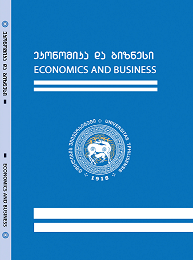
ივანე ჯავახიშვილის სახელობის თბილისის სახელმწიფო უნივერსიტეტის ეკონომიკისა და ბიზნესის ფაკულტეტის რეფერირებადი და რეცენზირებადი საერთაშორისო სამეცნიერო-ანალიტიკური ჟურნალი

ეკონომიკური გამოწვევები COVID-19-ის პერიოდში და პოსტ-პანდემიურ ეპოქაში
სტატიაში სხვადასხვა ქვეყნის სტატისტიკაზე დაყრდნობით განხილული და გაანალიზებულია მსოფლიო ეკონომიკების პანდემიისწინა მდგომარეობა და კორონავირუსის გავრცელებით გამოწვეული ეკონომიკური პრობლემები, რეალობები და პერსპექტივები. სტატიაში ასევე წარმოდგენილია სხვადასხვა ქვეყნის მთავრობების და მათ შორის საქართველოს ხელისუფლების ის ანტიკრიზისული ღონისძიებები, მონეტარული, ფისკალური და სოციალური მიმართულებით, რაც მნიშვნელოვანია კრიზისის უარყოფითი შედეგების დაძლევის მიმართულებით.
საკვანძო სიტყვები: კრიზისი, რეცესია, ეკონომიკური ზრდა, მონეტარული პოლიტიკა, ფისკალური პოლიტიკა, საბიუჯეტო პოლიტიკა, ბიუჯეტის დეფიციტი, საჯარო ფონდები, სახელმწიფო ვალი, საბანკო სისტემა, მაკროეკონომიკა, პანდემია, კორონავირუსი, კოვიდ-19.
JEL Codes: E52, E62, F40, F43, O2
Economic Challenges During COVID-19 and Post-Pandemic Era
Condition of world economies in the pre-pandemic state is discussed and analysed in the present article on the grounds of statistical data released by various countries, along with the economic challenges caused by the spread of COVID-19, with realities and prospects for future. Article also conveys information on the anti-crisis measures in monetary, fiscal and social dimensions designed by governments of various countries, including Georgia. What is most important, it elaborates on the efforts intended to overcome the negative consequences of the crisis.
Keywords: crisis, recession, economic growth, monetary policy, fiscal policy, budget policy, budget deficit, public funds, public debt, banking system, macroeconomy, pandemic, Coronavirus, COVID-19.
JEL Codes: E52, E62, F40, F43, O2
COVID-19 pandemic is having a significant impact on the world economic order and processes shaped over centuries. It causes changes in them and will fundamentally change them in future. So-called mainstream economic approaches are revalued and will be more revisited in future.
Before elaborating on the economic impact, challenges and essential economic measures in the context of a novel Coronavirus, I wish to briefly review the world economic position in the pre-COVID phase.
World financial crisis witnessed back in 2008 and economic developments in 2014 have conditioned a distortion and adjustment of traditional economic processes and tendencies, which were manifested in the declining economic growth rates, fluctuations of currency exchange rates and sharp increase of inflation in some cases, deflationary trends in some cases and other occurrences observed in individual states and regions.
Oil prices have been fluctuating sharply since 2014 and have had a declining trend. Brent trademark oil cost 115 USD in June 2014. Price for a barrel of oil dropped from a peak to an average of 53 USD in 2017, 69 USD in 2018, 60 USD in 2019 and ranged between 19-57 USD in the first 5 incomplete months of 2020.
Prices on mineral ores, technical metals and major feedstock groups have been declining in recent years.
A so-called trade and tariff war between the USA (largest economy of the world and 21.4% of the global GDP) and China (second largest economy of the world and 14.1% of the global GDP) has been turning fierce since 2018, which was manifested in the curbed imports and investments from China (import of commodities from China in the value of almost 550 billion USD was subject to a customs duty rated at 15-30%). USA also adjusted the North American Free Trade Agreement (NAFTA) which engages USA, Canada and Mexico, and is currently revisiting the terms and conditions laid out in the Free Trade Agreement concluded with the European Union (almost 20% of the global GDP) tilting them towards its own interests.
By 2019 positive economic trends were witnessed only in the USA (GDP increased by 2.3%, low inflation indicator was 1.6%, unemployment – 3.5%, thus producing the best indicators in almost 50 past years) among the leading economies of the world and practically all other economies acted in an unstable and fragile manner (including the economic growth rate of China in 2019 at about 6%, which was the lowest indicator over the past 25 years).
That was – conversely speaking – a fragile, unstable and unclear economic position of the world at the dawn of COVID-19 and besides we entered the new reality absolutely unprepared.
Mankind was challenged by an unprecedented development in economic terms, when the economy experienced blows from both sides – demand shock and supply shock. At the same time, reason was also unordinary as it is neither macroeconomic, nor fiscal or monetary and even sectoral. It was stemming from public healthcare.
It may well be said that the pandemic has shaken the world, thereby paralyzing and throwing the world economic order to the ground.
US economic growth rate in Q2 of 2020 was -9.1% compared to the respective period of the previous year. Unemployment increased, consumer and capital expenditures declined, exports dropped and so on. The EU economy shrunk by 13.9% in Q2 of 2020 in contrast with the respective period of the previous year.
Significant volatilities are observed at the financial markets of the world.
Only 9 months have passed since the dawn of the pandemic and it is still premature to make an assessment, while projections are utterly risky. Nevertheless, a certain picture is clearing up on the grounds of data released by the International Monetary Fund (IMF), World Bank (IBRD), European Bank for Reconstruction and Development (EBRD), US Department of Commerce, US Department of Labor and reputable research institutions.
Preliminary projections evidence that the US economy will be contracting at 5.9% in 2020, Japanese economy – at 5.2%, German economy – at 7%, UK economy – at 6.5%, French economy – at 7.2%, Italian economy – at 9.1%, Dutch economy – at 7.5%, Canadian economy – at 6.2%, economies of the Euro zone – at about 6%, Russian economy – at 8%, Turkish economy – at 8-9%. Chinese economy will have the lowest economic growth indicator (1.1%) since 1976. Relatively lower decline is expected in the economies of Asian countries.
Such recession has not been remembered by the world since the great depression witnessed in 1929-1933.
World has entered a phase of economic contraction with a demand of reduced solvency, cheap money, excess indebtedness and financial fluctuations.
In the given circumstances, following is expected at a global level:
1. Sharp increase of the unemployment level – it is expected to see unemployment rise to 10.4% in the countries of the Eurozone in 2020, while to 8% in the USA.
2. Increase of budget deficit - revenues to the budget will reduce (primarily in terms of tax revenues), while demand on budget expenditures will rise (expenditures of social nature and funding in support of businesses will increase). According to the projections, budget deficit in countries of Eurozone will reach 7.5% of GDP (instead of 0,7% witnessed in 2019), 15.4% in the USA, 7.1% in Japan, 5.5% in Germany, 8.3% in the UK, 9.2% in France, 11.8% in Canada, 9.5% in Spain, 8.3% in Italy and 6% on average in emerging economies.
3. Increased public debt – governments will have to finance the urgent measures with public debt. This indicator will probably increase to 131.1% of GDP in the USA, to 251.9% in Japan, to 68.7% in Germany, to 95.7% in the UK, to 155.5% in Italy, to 109.5% in Canada, to 113.4% in Spain and so on.
Entire world, including Georgia, is facing such reality and challenges nowadays.
Three directions are put forward within the context of measures designed to overcome the socio-economic problems caused by the global pandemic:
1. Fiscal measures, which entail the social security of population and incentives for businesses through direct and indirect facilities;
2. Monetary measures, which are focused on the supply of cheap money to the economy, increased refinancing and extension of quantitative easing policies;
3. Ensured liquidity, creditworthiness and sustainability of the financial and banking system.
By recent data, governments have in total allocated over 9 trillion USD for fiscal support purposes (including 4.4 trillion USD intended for the direct budget support and 4.6 trillion USD for loans, guarantees and capital injections). Central banks of countries are sharply (often in an unprecedented manner) reducing the interest rates and providing additional liquidity through discounted transactions to the market, thereby developing mechanisms for the resolution and sanitation of financial institutions.
Georgia completed 2019 with an economic growth of 5.1%, unemployment level reduced to 11.6% and inflation of 7%. Main challenges of our society were the price increase, excess indebtedness and scarcity of disposable income.
According to the data released in Q1 of 2020, Georgia had its GDP increased by 1.5%, while the GDP was reduced by 5.3% in contrast with the respective period of the previous year according to the data released in August 2020. Annual inflation reached 3.8% by September. Tourism sector is getting a painful blow (9.3 million visitors and 3.2 billion USD in revenues generated throughout 2019). Overall, we will have a decline in remittances (1.5 billion USD net inflows observed in 2019). Export is dropping (-14.7%), while it had a stable increase in recent years and exceeding the import growth trend by 10-12%. Foreign direct investments (FDI) will probably drop. Contraction will be observed in the construction sector, translations related to real estate, financial and insurance operations, trade, production and manufacturing, etc.
The Government of Georgia openly declared that recession is expected in the country and adjusted the projected economic growth indicator from 4.5% to at least -4% (State Budget projections for 2021 refer to -4.9%). At the same time, State Budget will spend about 3.9 billion GEL for the management of the crisis:
· Care and social security of citizens in various categories will be the aim of budget allocations in the amount of 1.035 billion GEL;
· Care for the economy and support of entrepreneurship will be the aim of budget allocations in the amount of 2.110 billion GEL;
· Improvement of the healthcare system and fight against the pandemic will be the aim of budget allocations in the amount of 350 million GEL;
· Capital expenditures will be further increased by 300 million GEL and so on.
Anti-crisis plan has been developed, which will be concentrated on the following directions apart from the social security of the population:
· Recovery of tourism, which entails tax breaks, support of accommodation facilities, eateries, travel agencies and guides, etc.
· Care for the rural areas and farmers, inter alia, including the incentives for the agriculture land owners, programs entailing provision of diesel fuel for agricultural purposes, concessional loans for agriculture, facilitation of agro-industrial activities, agri-insurance, development of agro-industrial cooperatives, etc.
· Support of businesses, inter alia including the subsidies for loans and leasing, credit guarantee scheme, support of micro and small entrepreneurship, etc.
Georgia plans allocate about 9 billion GEL overall for the crisis management and recovery of the economy in the post-pandemic phase, mainly at the expense of external loans and support. It will include about 4.5 billion GEL in the public sector and 4.5 billion GEL in the private sector through loans, guarantees, etc.
It also needs to be taken into account that according to the data released in Q1 of 2020, all 15 commercial banks operating in Georgia have incurred losses in the total amount of 747 million GEL, which is about 1.5% of the country’s GDP or 2.9% of deposits. Commercial banks of Georgia have provisioned 1.22 billion GEL for potential asset losses, which reflect the possible losses on loans. Nevertheless, their operating activities are still profit-making and in the first 9 months of 2020 losses were reduced to 252 million GEL. Commercial banks have a sufficient equity buffer, which enables them to absorb the losses, while the central bank of the country has efficiently enforced additional tools of liquidity supply (SWOP transactions, etc.) to compensate the reduced cash flow into the commercial banks.
In the conditions of high dollarisation of the economy and equally high dependency on imports, situation is further jeopardised in the reality of Georgia by the supply of cheap money through monetary channels and increased funding through fiscal channels, which is significantly reflected in the exchange rate of the national currency, price increase and solvent demand and poverty level.
Curb of the economic downfall, exit from the recession and return to the advancing trend will significantly depend on the second wave of the pandemic and ultimate victory over COVID-19 and/or definition of rules (culture) for co-existence with it. Overall, economies will enter the post-pandemic phase with an increased budget deficit, increased public debt, increased non-performing assets in the financial and banking sector, reduced disposable income and altered sectoral structure of the economy.
References:
- Kovzanadze I. (2020). Economic Challenges and Prospects Against the Background of COVID-19 Infection. “Economy and Business”, Tbilisi, vol. XII, N2.
- Kovzanadze I. (2019). Financial Support Policy for Agriculture at the Modern Stage. „Economy and Business“, Tbilisi, vol. XII, N1.
- Kovzanadze I. (2018). Global Economy: Post-Crisis to Sustainable Development. “iUniverse Inc.”, Bloomington.
- Kovzanadze I. (2010). Systemic and Borderline Banking Crises: Lessons Learned for Future Prevention. “iUniverse Inc.”, New York, Bloomington.
- Kovzanadze I. (2010). Lessons Learned from the Global Crisis: New Model of Economic Regulation Needed. “ Voprosy Ekonomiki”, Moscow, N4.
- www.geostat.ge
- www.gov.ge
- www.mof.ge
- www.economy.ge
- www.nbg.gov.ge
- www.img.org
- www.worldbank.org
- www.ebrd.com
- www.oecd.ge








